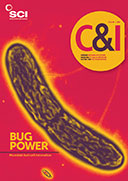Modern marvels – from plants
Reviewer
John Mann
Title: Botanical miracles: chemistry of plants that changed the world,
Authors R. Cooper and J.J. Deakin
Publsher: CRC Press, Boca Raton,
Year: 2016,
Pages: 252,
Price: £65,
ISBN: 978-1-4987-0428-1
At least 25% of prescription drugs are based upon natural products or their structural analogues. This figure rises to 40% if one considers antibiotics and anti-cancer drugs. Although many of these agents are of microbial origin, there are several real ‘botanical miracles’ as well.
One such plant-based miracle is the often forgotten sapogenin diosgenin from the Mexican yam Dioscorea mexicana, which formed the basis for the discovery of the contraceptive steroids. In 1939, the American chemist Russell Marker showed that it was possible to convert diosgenin into progesterone in three chemical steps. This hitherto very expensive female hormone was known to be intimately involved in the maintenance of the pregnant state and hence a key player in fertility control. Having failed to interest US companies in his discovery, Marker sought help from the small Mexican company, Laborotorios Hormona in 1944. Their collaboration led to the evolution of the pharmaceutical company Syntex and to the discovery of the highly potent progestin norethindrone by Carl Djerassi, Luis Miramontes and George Rosenkrantz in 1951. Following a decade of clinical evaluation, norethindrone became the basis for the contraceptive pill in 1961, and this drug has revolutionised the way women control their fertility – a true ‘botanical miracle’.
While Russell Marker knew that the yam contained steroidal compounds, Monroe Wall and Mansukh Wani and colleagues at the Natural Products Laboratory of the Research Triangle Institute in North Carolina, US, could not have guessed that the complex diterpenoid taxol they isolated from the Pacific yew tree Taxus brevifolia in 1971, would become one of the most exciting anti-cancer agents of the late 20th century. Twelve years of large-scale extraction of yew bark yielded enough taxol for early clinical trials, but seriously threatened the survival of the species. Fortunately, the foliage of the European yew, Taxus baccata, was shown to contain another diterpenoid, 10-deacetylbaccatin III that could be easily converted into taxol.
Taxol is now widely used especially for the treatment of breast, lung and ovarian cancers. One amusing adjunct to this story is that Bristol-Myers Squibb, the developer of the drug, patented the name taxol – an hitherto unheard of process for a natural product – and we should now call this ‘botanical miracle’ paclitaxel.
These and other medical marvels like quinine, aspirin, vinblastine and vincristine are discussed in this book, but the ‘botanical miracles’ also include less obvious plant products. So ‘miracle foods’ include quinoa, wheat, rice and garlic, together with the beverages, tea, coffee and cocoa. Plants also produce euphorics like opium, tetrahydrocannabinol, cocaine and nicotine, or exotic lotions, potions and oils like inter alia frankinsense, myrrh, lavender and aloe. Finally plants also provide dyes and pigments.
If this list seems eclectic, the choice of associated chemistry is often unexpected or even odd. For example, a brief discussion of peroxide chemistry in the section on the naturally occurring, anti-malarial drug artemisinin is perhaps appropriate since its mode of action involves cleavage of its endogenous peroxy linkage. Similarly, the lactone-containing digitalis from the foxglove provides a reasonable enough excuse for a digression into basic alcohol and ester chemistry. But the story of taxol is accompanied by an extensive introduction to terpenoid chemistry, isomers, chirality and a sudden lurch into NMR spectrometry of organic compounds. All of these are specialised topics and their relevance to taxol chemistry is not explained.
More surprising is the list of topics considered in the section on wheat, which includes the historical origins, germination, lignans, proteins and amino acids, details of the shikimic acid pathway, wheat genetics and gene modification of crops. Surely an eclectic spread of information more suited to a polymath than university students, yet this is the target group the authors want to reach.
As long as one accepts this style of topic presentation, the book is not without merit. The chapter on euphorics ranges widely from opium and heroin to cannabis, cocaine and tobacco (nicotine). It includes historical information and basic medicinal properties together with fundamental amine and amide chemistry and an introduction to N-heterocyclic compounds. Exotic potions and lotions are represented by camphor, frankinsense, myrrh, lavender and aloe with discussions of classical uses, carbohydrate chemistry, polysaccharides, chromatography, basic carbonyl chemistry and IR spectroscopy. Finally, the colourful chemistry chapter is possibly the most focused, commencing with photosynthesis before describing UV spectroscopy and the chemistry of various natural pigments including chlorophyll, carotenoids, indigo, quinones, flavonoids and pH indicators.
The authors clearly hope that the book will become a teaching text since each section is prefaced by a statement of curriculum content and ends with a series of questions and (very old) references. I fear that its price will deter most students who will also want more depth and focus; but for the scientifically literate, casual reader it could provide some fascinating facts though they will probably struggle with the chemistry.
John Mann is emeritus professor of chemistry at Queen’s University Belfast, UK
The best way to keep up to date with all of the latest, cutting edge technologies from the lab to the market!
Author
Publisher
Pages
Price
ISBN





